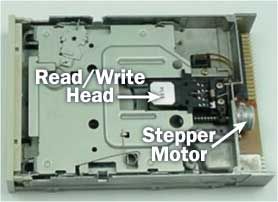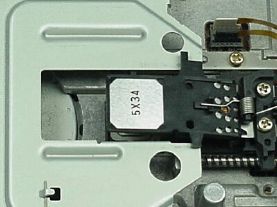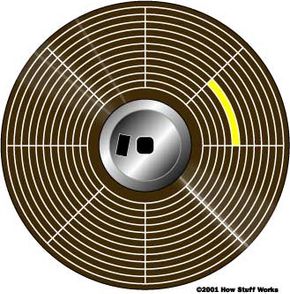Parts of a Floppy Disk Drive
The Disk
A floppy disk is a lot like a cassette tape:
- Both use a thin plastic base material coated with iron oxide. This oxide is a ferromagnetic material, meaning that if you expose it to a magnetic field it is permanently magnetized by the field.
- Both can record information instantly.
- Both can be erased and reused many times.
- Both are very inexpensive and easy to use.
If you have ever used an audio cassette, you know that it has one big disadvantage -- it is a sequential device. The tape has a beginning and an end, and to move the tape to another song later in the sequence of songs on the tape you have to use the fast forward and rewind buttons to find the start of the song, since the tape heads are stationary. For a long audio cassette tape it can take a minute or two to rewind the whole tape, making it hard to find a song in the middle of the tape.
Advertisement
A floppy disk, like a cassette tape, is made from a thin piece of plastic coated with a magnetic material on both sides. However, it is shaped like a disk rather than a long thin ribbon. The tracks are arranged in concentric rings so that the software can jump from "file 1" to "file 19" without having to fast forward through files 2-18. The diskette spins like a record and the heads move to the correct track, providing what is known as direct access storage.
The Drive
The major parts of a FDD include:
- Read/Write Heads: Located on both sides of a diskette, they move together on the same assembly. The heads are not directly opposite each other in an effort to prevent interaction between write operations on each of the two media surfaces. The same head is used for reading and writing, while a second, wider head is used for erasing a track just prior to it being written. This allows the data to be written on a wider "clean slate," without interfering with the analog data on an adjacent track.
- Drive Motor: A very small spindle motor engages the metal hub at the center of the diskette, spinning it at either 300 or 360 rotations per minute (RPM).
- Stepper Motor: This motor makes a precise number of stepped revolutions to move the read/write head assembly to the proper track position. The read/write head assembly is fastened to the stepper motor shaft.
- Mechanical Frame: A system of levers that opens the little protective window on the diskette to allow the read/write heads to touch the dual-sided diskette media. An external button allows the diskette to be ejected, at which point the spring-loaded protective window on the diskette closes.
- Circuit Board: Contains all of the electronics to handle the data read from or written to the diskette. It also controls the stepper-motor control circuits used to move the read/write heads to each track, as well as the movement of the read/write heads toward the diskette surface.
The read/write heads do not touch the diskette media when the heads are traveling between tracks. Electronic optics check for the presence of an opening in the lower corner of a 3.5-inch diskette (or a notch in the side of a 5.25-inch diskette) to see if the user wants to prevent data from being written on it.


